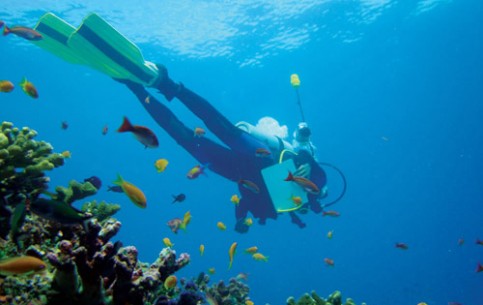Coral bleaching in the Seychelles in 1998
In 1998, the coral reefs of the Seychelles were affected by the El Nino Southern Oscillation. The exact cause for this event is unknown but it is thought global warming was primarily to blame. The changes in the atmosphere caused an increase in sea temperatures, resulting in significant consequences for the surrounding coral and marine life. The warmer waters caused the coral to repel the bright algae (which gives the coral its vivid colours) from their tissues, thus causing them to take on a pale and white appearance (hence the commonly used term “coral bleaching”). The inner reefs were hit harder than the outer reefs, however the granitic nature of the reefs meant they were not as badly affected as first feared, and 11 years on from the event there has been a remarkable recovery and the diving generally remains excellent.
When to go scuba-diving in the Seychelles
With dive sites ranging in depth from 8m to 30m there are options for both beginners and experienced divers to enjoy. It is possible to dive throughout the year in the Seychelles – however waters are calmest during the months of March, April and May and September, October and November. During these months visibility can reach a staggering 30m and with water temperatures reaching 29oc it makes for a very pleasant and relaxed diving experience. The calmer waters also mean dive boats can reach the more remote sites, where encounters with mega fauna such as sharks and manta rays are common – these sites are particularly good for experienced divers.
During the months June, July and August the south-east monsoon brings stronger winds making access to the more remote dive sites difficult and unreliable. Cooler waters are blown in and temperatures drop to around 25oc. These cooler waters are filled with nutrient rich plankton so visibility can be significantly reduced; however these nutrients encourage the appearance of whale sharks, which can reach an incredible 10m in length. Local dive shops offer specific whale shark programmes during these months, so the chance to snorkel or even dive with these magnificent creatures is very high.
Marine life
Around the inner reefs, marine life you can expect to see among others includes – angelfish, butterflyfish, octopus, lionfish, nudibranchs and mantis shrimp. Slightly further out, napoleon and humphead wrasses, schools of humphead parrotfish, stingrays, reef sharks and green and hawksbill turtles are common.
Sailfish, silvertip, oceanic whitetip and nurse sharks, manta rays and whale sharks are more common around the remoter outer islands – you may even be able to spot the occasional hammerhead shark if you're lucky!
Where to go diving in the Seychelles
When you are a guest with us, we will have all the equipment on board and take you to the best spots. We will of course have the relevant dive masters/instructors available to you as well.
Other local dive schools are also available on the various islands.
Some photos of what to expect

Many thanks to http://www.expertafrica.com/seychelles/info/diving-in-the-seychelles







Yacht Chater Dubai this is amazing place I have ever seen. Love the ride…
ReplyDelete